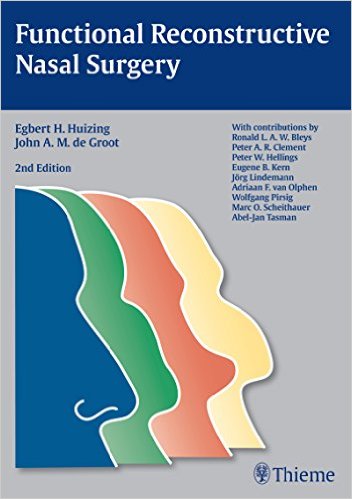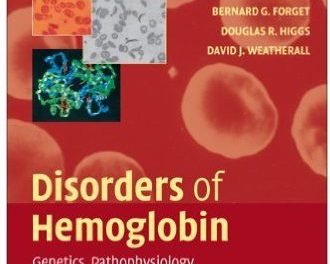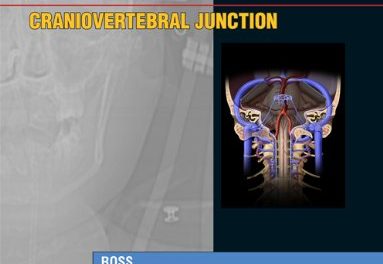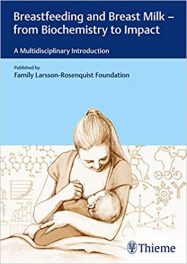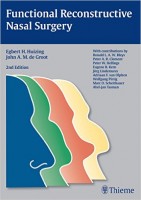 Authors and Editors: Egbert H. Huizing, MD and John A.M. de Groot, MD
Authors and Editors: Egbert H. Huizing, MD and John A.M. de Groot, MD
Publisher: Thieme – 413 pages, with 869 illustrations
Book Review by: Nano Khilnani
While otorhinolaryngology is the study of the ear, nose and throat, the focus of this book is only the nose, and in particular reconstructive nasal surgery. It provides detailed sketches with measurements for each surgical procedure to be performed. It contains detailed information and guidance on such matters as dimensions, proportions, Western standards, horizontal, vertical and lobular base divisions, and other such considerations in reconstructing the nose.
Some of the common physical situations that reconstructive procedures can correct are: abnormalities (a variety of deviations from the normal), anatomical variations, defects, and deformities. For example, there are some individuals who have an asymmetric nose, bony nose, a cleft-lip nose, cleft-palate nose, deviated pyramid nose, flat nose, high nose, hump nose, long nose, low nose, narrow nose, open roof nose, saddle nose, short nose, ski slope nose, twisted nose, wide nose, and other undesirable features of a nose.
Some physiological conditions (caused by physical abnormalities sometimes) that can be normalized with surgeries are: allergic conditions, breathing difficulties (caused by narrow nostrils, maybe), dry nose syndrome, sinus disease sneezing, snoring, speech problems, and wide nasal cavity (‘empty nose’).
This book is being used in numerous teaching clinics and hospitals in Europe, the United States, South America, and Asia. The first edition was also published in Chinese, Italian, and Turkish languages. It has become so popular that even illegal copies have been produced.
Eleven professors and practitioners of otorhinolaryngology, rhinology, surgery, and clinical anatomy wrote the nine chapters and contributed other material for this book. They are from the Netherlands and these other countries: Belgium, Germany, Switzerland, and the United States. Here is an overview of what is covered in this book:
- Basics
- Pathology and Diagnosis
- Surgery – General
- Incisions and Approaches
- Septal Surgery
- Pyramid Surgery
- Lobular Surgery
- Surgery of the Nasal Cavity
- Special Subjects
Chapter 4, Surgery – General is an important component of this book. It covers the concepts and basic principles of reconstructive nasal surgery. Below we quote some of them.
Concepts:
“The primary objective of nasal surgery should be to restore nasal function. The nose evolved to facilitate smelling and breathing, to detect odors, to control the inspiratory and expiratory airstream, to humidify and warm inspired air, and to serve as the first line of defense of the respiratory tract.”
“Nasal surgery or rhinoplasty should be functional and reconstructive. In the words of Kern, we must ‘recreate normality’ …we attempt to restore function by reconstructing normal anatomy.”
Basic Principles:
“To achieve our goals of reconstituting function and form, we apply the following three basic principles:
- The septum and pyramid area are corrected in one procedure
- The lobule is preferably modified in the same procedure
- In patients with extensive pathology, surgery may be performed in two stages…”
Some of the benefits of owning this book are:
- A magnificent art program of more than 850 detailed surgical drawings and photographs that elucidate every concept
- A logical continuum from essential anatomic concepts to specific incisions and surgical approaches to the septum, pyramidal lobule, turbinates, and nasal cavity
- Special sections on pediatric nasal surgery, transplants, acute nasal trauma, mentoplasty, implants, patient complaints, and medico-legal issues.
- Extensive appendices of materials, instruments, nomenclature, and historical developments
- Every chapter revised and updated with expanded sections on complications, new techniques for saddle nose correction, and much more
Editors:
Egbert H. Huizing, MD, PhD is Professor Emeritus and Former Chairman of the Department of Otorhinolaryngology at University Medical Center Utrecht in Utrecht, the Netherlands.
John A.M. de Groot, MD, PhD is Former Assistant Professor in the Department of Otorhinolaryngology at University Medical Center Utrecht in Utrecht, the Netherlands.
Contributors:
Ronald L.A.W. Bleys, MD, PhD is Professor of Clinical Anatomy at Medical Center Utrecht in Utrecht, the Netherlands.
Peter A.R. Clement, MD, PhD is Emeritus Professor of Otorhinolaryngology at Free University Brussels in Ixelles, Belgium.
Peter W. Hellings, MD, PhD is Professor of Otorhinolaryngology at University Hospital Leuven in Leuven, Belgium.
Eugene B. Kern, MD, PhD is Emeritus Professor of Rhinology and Facial Plastic Surgery at Mayo Clinic Medical School in Rochester, Minnesota.
Jorg Lindemann, MD, PhD is Professor of Otorhinolaryngology in the Department of Otorhinolaryngology and Head & Neck Surgery at University Hospital Ulim in Ulim, Germany.
Adriaan F. van Olphen, MD, PhD is former Assistant Professor of Otorhinolaryngology at University Medical Center Utrecht in Utrecht, the Netherlands.
Wolfgang Pirsig, MD, PhD is Emeritus Professor of Otorhinolaryngology at University of Ulim in Ulim, Germany.
Mark O. Scheithauer, MD, PhD is Professor of Otorhinolaryngology in the Department of Otorhinolaryngology and Head & Neck Surgery at University Hospital Ulim in Ulim, Germany.
Abel-Jan Tasman, MD, PhD is Privat-Dozent of Otorhinolaryngology at Kantonsspital St. Gallen in St. Gallen, Switzerland.

